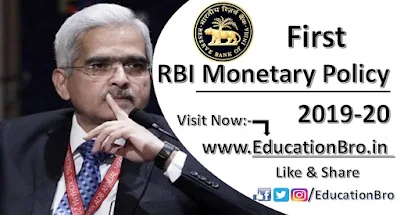 |
| RBI has announced First Bi-Monthly Monetary Policy Statement 2019-20:- Point-to-Point Details |
RBI has announced First Bi-Monthly Monetary Policy Statement 2019-20:- Point-to-Point Details
RBI Governor Shaktikanta Das has announced the First Bi-monthly Monetary Policy Statement for the year 2019-20. (April 4th 2019)
On the basis of an assessment of the current and evolving macroeconomic situation at its meeting, the Monetary Policy Committee (MPC) decided to:-
Reduce the policy Repo Rate under the liquidity adjustment facility (LAF) by 25 basis points to 6.0 per cent from 6.25 per cent with immediate effect.
Consequently, the reverse repo rate under the LAF stands adjusted to 5.75 per cent, and the marginal standing facility (MSF) rate and the Bank Rate to 6.25 per cent.
The Cash Reserve Ratio (CRR) of scheduled banks unchanged at 4.0% of (NDTL).
Current RBI Policy Rates Given Below:-
|
Policy
Repo Rate
|
6.00%
|
|
Reverse
Repo Rate
|
5.75%
|
|
Marginal
Standing Facility (MSF) Rate
|
6.25%
|
|
Bank
Rate
|
6.25%
|
|
Cash
Reserve Ratio (CRR)
|
4%
|
|
Statutory
Liquidity Ratio (SLR)
|
19.00%
|
RBI Monetary Policy Tools | Monetary Policy Instruments
These decisions are in consonance with the objective of achieving the medium-term target for consumer price index (CPI) inflation of 4 per cent within a band of +/- 2 per cent, while supporting growth.
Turning to the domestic economy, the second advance estimates for 2018-19 released by the Central Statistics Office (CSO) in February 2019 revised India’s real gross domestic product (GDP) growth downwards to 7.0 per cent from 7.2 per cent in the first advance estimates. Domestic economic activity decelerated for the third consecutive quarter in Q3:2018-19 due to a slowdown in consumption, both public and private.
However, gross fixed capital formation (GFCF) growth remained in double digits for the fifth consecutive quarter in Q3, with the GFCF to GDP ratio rising to 33.1 per cent in Q3:2018-19 against 31.8 per cent in Q3:2017-18, supported primarily by the government’s thrust on the road sector and affordable housing. The drag on aggregate demand from net exports also moderated in Q3 due to a marginal acceleration in exports and a sharp deceleration in imports led by a decline in crude oil prices.
Retail inflation, measured by y-o-y change in the CPI, rose to 2.6 per cent in February after four months of continuous decline. The uptick in inflation was driven by an increase in prices of items excluding food and fuel and weaker momentum of deflation in the food group. However, inflation in the fuel group collapsed to its lowest print in the new all India CPI series.
The next meeting of the Monetary Policy Committee (MPC) is scheduled from June 3, 4 and 6, 2019.







0 Comments